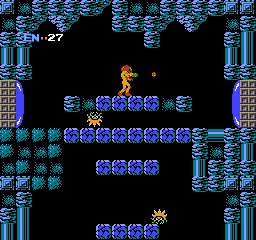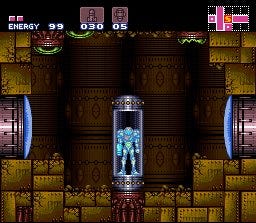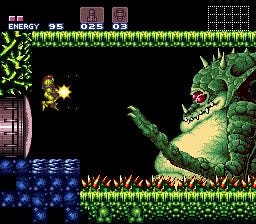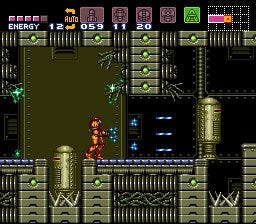1994, The Most Important Year in Gaming, Part 2: Super Metroid
Among other things, 1994 includes one of the biggest genre-defining titles in video game history.
This article is part of a series! Also check out 1994, Part 1: Sega.
Written by Tink Edwards
Super Metroid. For many gamers of a certain age, the name is associated with the apex of the medium. The promise of a grand, cinematic graphical adventure finally made tangible. It’s a game so influential that an entire genre bears its name. Coined by former Retronaut and 1Up employee Scott Sharkey, the term Metroidvania has endured since it was first uttered in some long-forgotten indie column or forum post (there’s also the possibility that a Google Groups user named Richard Hutnik created the term) and is pretty much the de facto word to use when describing any 2D exploration-based action game. The other half of the Metroidvania moniker comes from Castlevania: Symphony of the Night, which used the Super Metroid blueprint to create its own unforgettable experience. Since then, hundreds of titles have been released under the Metroidvania genre banner, cementing it as a staple experience in gaming.
As part of my ongoing retro coverage of 1994 (which, if you have read my introductory entry about Sega, you’d know I believe it to be the most important year in gaming), I’d like to explore Super Metroid in a way that examines the history of the game’s production, the actual content of the game, and the seemingly everlasting legacy it has. What makes it so special to so many people? I can’t wait to go on this journey with you. Please note that I will likely gush about the game at length. I hope you can forgive this.
Building a Brief History Map
The original Metroid on the NES was a big hit with Western audiences. The development team consisted of longtime Nintendo toymakers and fun-engineers Makoto Kano and Gunpei Yokoi, director and collaborator Satoru Okada, producers and designers Yoshio Sakamoto and Hinoji Kiyotake, and one of Nintendo’s many legendary composers – Hip Tanaka. A super group of who’s who Nintendo developers, the team created an atmospheric, semi-dark action platformer inspired by the work of director Ridley Scott and artist H.R. Giger. It was called Metroid, and it was good.
Yoshio Sakamoto stepped into the director’s chair for Super Metroid, with many members of the original Metroid team producing. The plan was to expand upon the first game and create a unique and haunting action game. Many of the ideas from Metroid were expanded and improved upon, such as the inclusion of an automap to help with traversal. The groundbreaking automap feature is a key component to many Metroidvania titles that followed Super Metroid, including Castlevania: Symphony of the Night. Beyond the quality of life and graphical improvements, composers Kenji Yamamoto and Minako Hamano replaced Hip Tanaka as music and sound designers. They were tasked with setting the mood for the game and created one of the most iconic soundtracks in the genre's history.
Metroid stars a space bounty hunter named Samus Aran. Partway through development of the original game, it was decided that Samus would be a woman, and that fact would be revealed to the player upon completion of the game. It was a cool design choice that helped Samus stand out from other action game stars at the time. Samus wears yellow-orange armor that I can only imagine was inspired by the yellow loader mech vehicle from Aliens. You know, the thing Ripley uses to defeat the alien queen?
She has a cosmic pterodactyl nemesis named Ridley (gee, I wonder what inspired that name?) – a space pirate that does the bidding of Mother Brain. We’ll get to them in a bit since I feel like I need to give a bit of a synopsis of the first couple of Metroid games before I get to Super Metroid, so bear with me as I stumble through the story beats as best as I can remember them.
What’s Going On Here?
Ridley and his space pirate buddies have captured a bunch of mysterious space jellyfish (Metroids), and it’s up to Samus to stop them from using the space jellyfish to make space weapons that could potentially destroy space. Space! Samus heads to the planet Zebes, where she explores its maze-like rooms, killing enemies and powering up her suit to uncover the mystery of the Metroids. Samus eventually defeats the pirates and their leader, Mother Brain, who is an evil brain in a giant jar. Good job, Samus!
In the Game Boy sequel, Metroid II: Return of Samus, Samus is tasked with eradicating every Metroid, as they’re a dangerous creature whose power of absorbing energy is perilous in the wrong hands. So, she heads to the Metroid home planet of SR388 and hunts them down, killing them all. Except for a single baby Metroid, freshly hatched. That Metroid cuddles up to Samus, thinking she’s its mother. Samus lets it live and delivers it to the space colony Ceres for testing. Hey, look at that. You’re all caught up on the lore! Now, we can finally get to…
Super Metroid!
“1994.” This is the first text we see (well, after the Nintendo logo) in Super Metroid. Reading it feels cold, inhuman, and lonely. It’s a bold move from the developers to be so confident in what they’re presenting that the year the game releases is the first thing they want people to see in their game. Shortly thereafter, we hear the spooky tones of Kenji Yamamoto and Minako Hamano’s score. They play over images of the Ceres lab, darkened by a power failure. Something bad has happened here. The words “Nintendo Presents Metroid 3” appear in between images of the bodies of multiple scientists lying dead on the floor. A strange animal screech can be heard. And then we see it. The Metroid baby, delivered by Samus at the end of her previous adventure. The game’s logo overlays a still shot of the baby Metroid, confined to its lonely test tube, surrounded by corpses. Pretty sweet, right?
“The last Metroid is in captivity. The galaxy is at peace.” These are the words we hear upon starting up a new save file. The robotic voice sample (provided by Dan Owsen – a Nintendo localizer at the time) sets the tone for the experience. It’s going to be creepy. It’s going to be quiet. We’re going to be alone. Where Metroid and Metroid II, possibly limited by technical constraints, couldn’t truly convey the dread one might feel watching Alien or any solitary narrative, Super Metroid instantly nails the atmosphere.
Samus gives a brief synopsis of the first two games. After a quick “you HAVE to lose” battle with Ridley on Ceres space colony, he flies off with baby Metroid in tow, and Samus hops into her ship to follow him… to planet Zebes. Landing on the surface, we hear the gloomy, droning ambient sounds of a dead planet, accompanied by cracks of thunder. At this point, the game truly begins, and we can freely explore the planet as we’d like.
Scratch that. We are initially railroaded a bit, as the game teaches us how to play and simultaneously conveys important visual storytelling elements. There are no enemies about. The only movement we see is the clusters of insects which scatter as we walk by. It’s incredibly eerie and makes you wonder what exactly happened here. After descending a long shaft we enter a door and see the shattered jar of Mother Brain. This is where Samus defeated her in the original game! Neat!
Continuing on, we soon find our first upgrade – the iconic Morph Ball – and a surveillance camera spots us. Uh oh. Doubling back up the path we took to get to the morph ball, we’re greeted with a slew of space pirates who were alerted to our presence and are out in full force. In fact, the entire planet seems to have awoken. It’s alive! Now that we know the mechanics and understand the point of the game, we can experience the top-notch ambiance, creature and world design, boss fights, and whatever else the game has to offer.
Having Said All That
With the basic tutorial sections of the game out of the way, Super Metroid opens up, allowing you to do… pretty much whatever you want. The game telegraphs what you’re supposed to do pretty well, but one of the beautiful things about Super Metroid is how you can, and are often encouraged to, sequence break. Don’t want to grab the hi-jump boots that double your jumping height? If you’re good enough at the wall-jump ability (which is completely optional, by the way), you can access nearly every area in the game that would normally require those boots.
There are a number of abilities like wall-jumping that aren’t required to traverse the planet, but the game gives you access to them anyway. For some of them, the few friendly animals found on the planet give little visual tutorials on how to use the abilities. Others are so well hidden, like the Crystal Flash, which lets you heal Samus using weapon ammunition, that you have to either use a guide or figure it out through dumb luck. Those types of secrets are great, as they give players so much power and freedom. It makes the game even more interesting, in case the narrative and atmosphere aren’t grabbing you.
You can choose to venture forth into the planet’s depths however you’d like. If you don’t want to break the game, playing it straight is just as satisfying and fun. Exploring the planet and collecting power-ups, weapons, energy tanks, and armor upgrades is a blast. I’d pay good money to wipe my memory of the game clean and discover it all over again. Everything is satisfying, and everything in the game exists for a reason. It’s a meticulously planned experience that just lands.
Lasting Appeal
Super Metroid has endured for 30 years. With its truly open world freedom and sequence-breaking abilities, it’s become quite popular with speedrunners and is routinely featured at Games Done Quick charity speedrunning events. While I encourage new players to take in the experience in its entirety, as methodically as possible, with the right knowledge and a decent amount of skill, a player can plow through the entirety of the game in under an hour. It’s not for lack of content that this is possible. The development team gives the player a huge toolset to empower them. This empowerment, combined with the expertly crafted world and story around the player, makes for an all-time gaming experience.
The influence of Super Metroid ripples far and wide. One of the designers of Castlevania: Symphony of the Night, Koji Igarashi, ran with the formula, creating a series of games made in Super Metroid’s image. Indie developer Team Cherry created Hollow Knight and cites Metroid as one game it wanted to emulate. Even large publishers like Microsoft hopped on the Metroidvania train with titles like Ori and the Will of the Wisps. “Search Action” games are here to stay, and their appeal doesn’t seem to be waning.
I was going to dive deeper into the lore of Super Metroid but decided against it. The people who have played the game already know all about it, and those of you who haven’t needn’t be spoiled. It’s an experience I’d like to keep as pure as possible for you. So, however you can, go out and play Super Metroid. It’s a once-in-a-generation game. Better than Pong, even.












